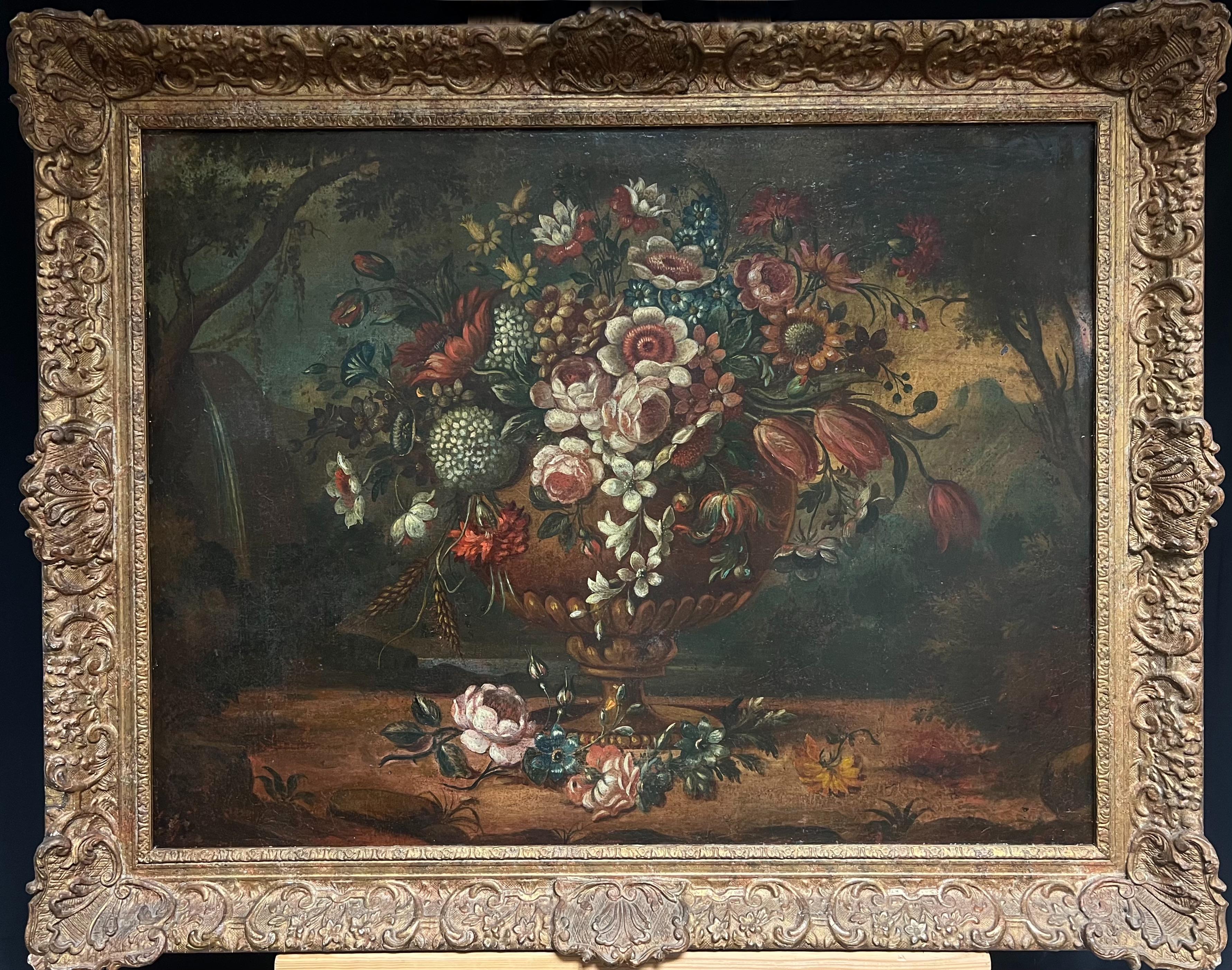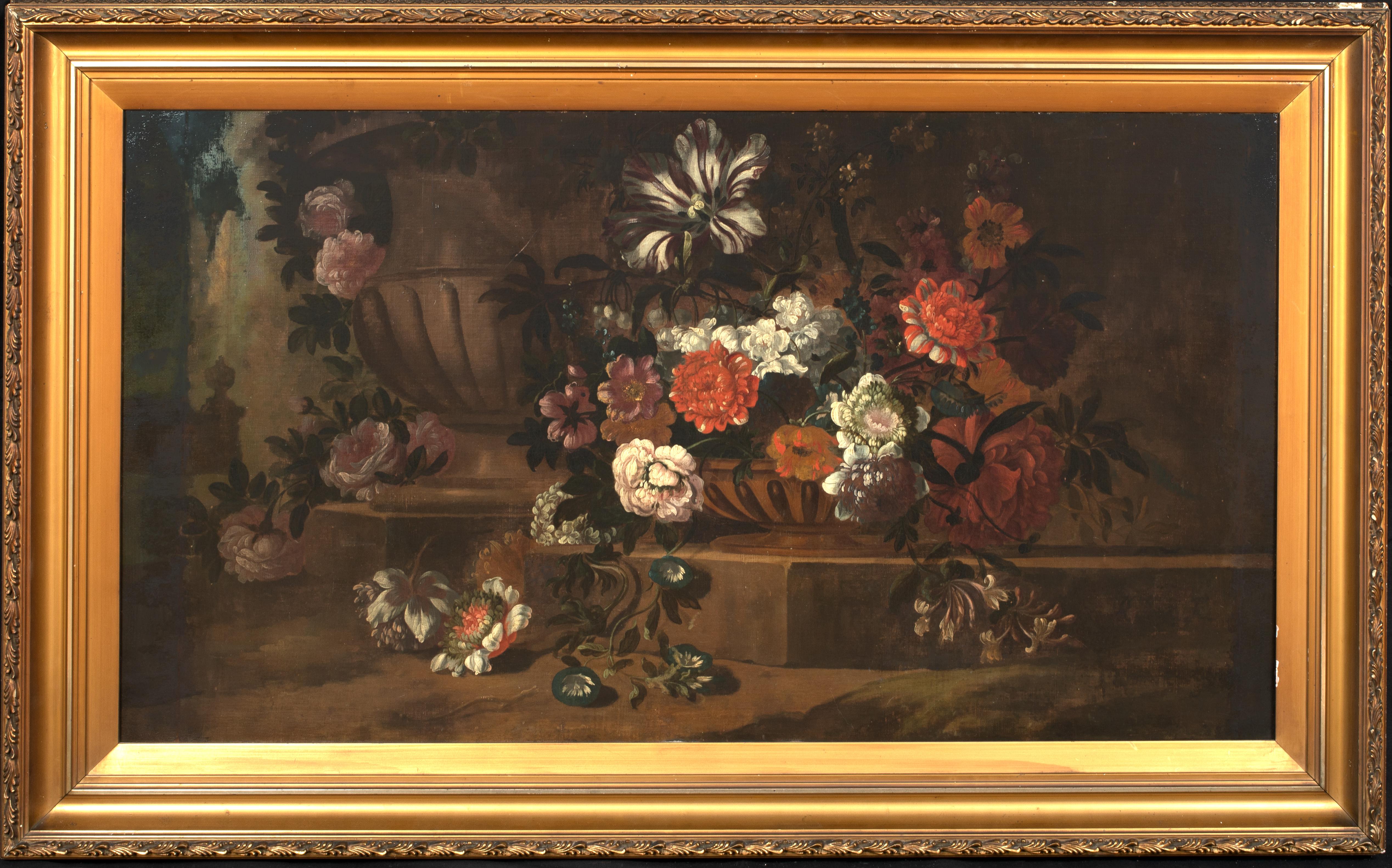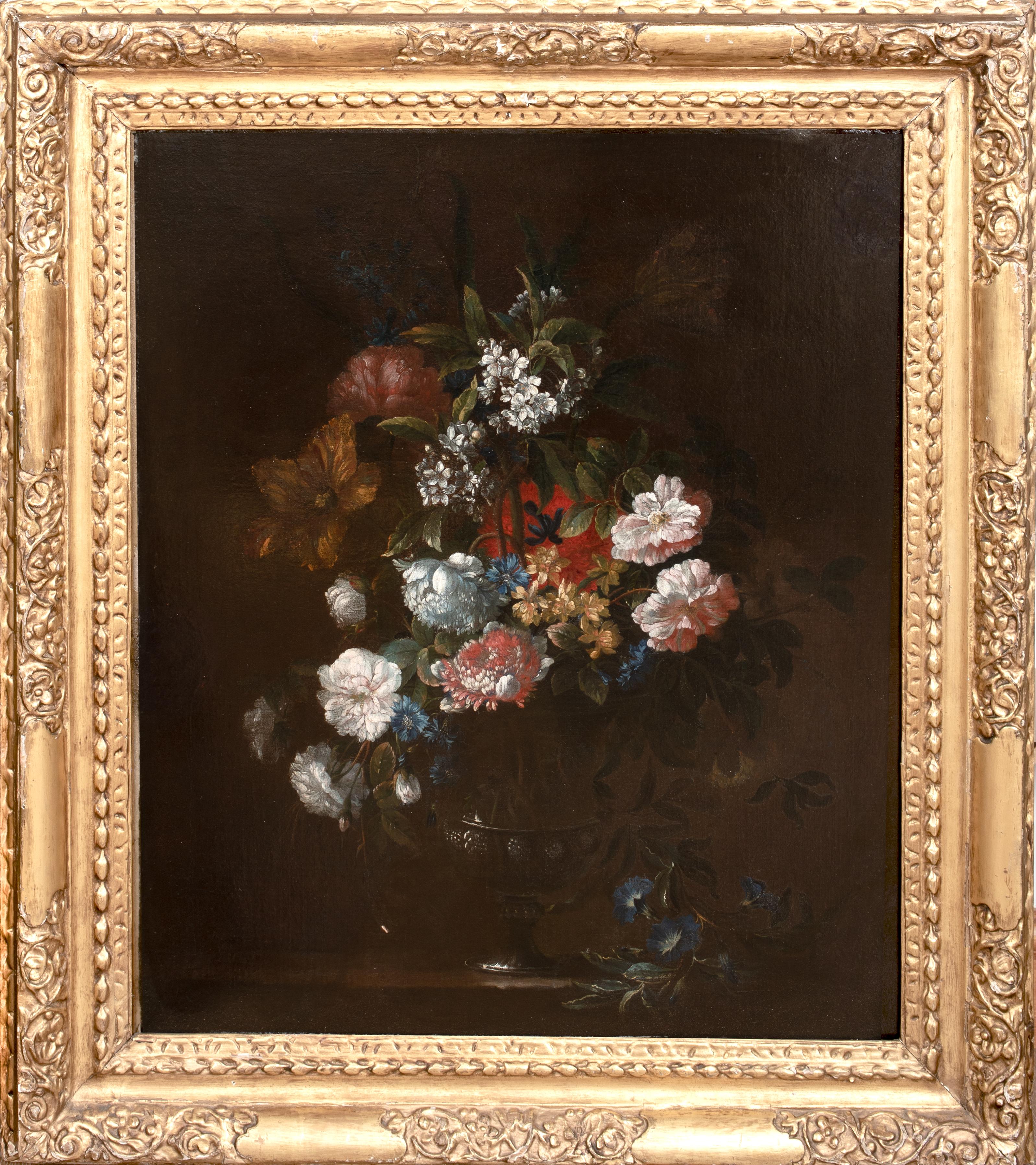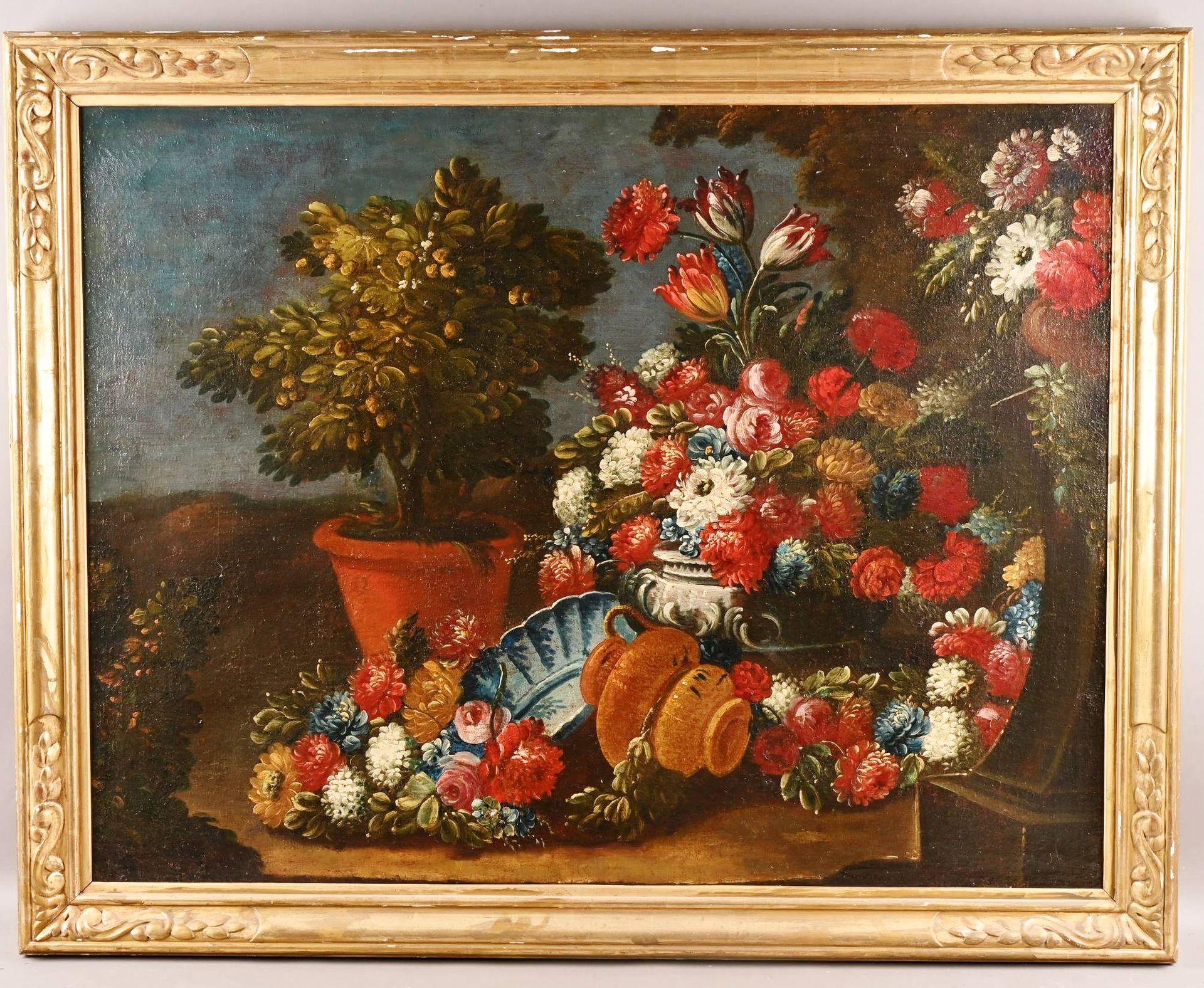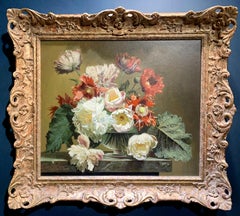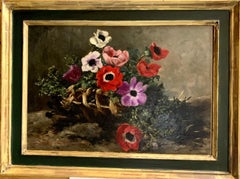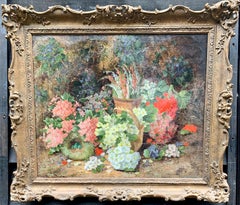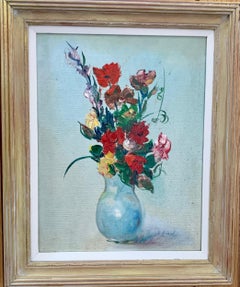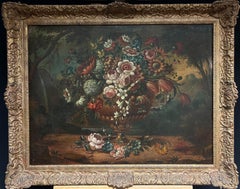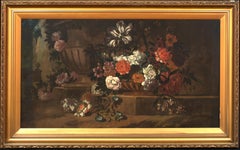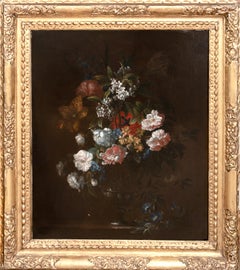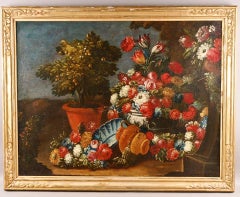Items Similar to 18th century Venetian Still life of flowers, classical vase on a marble ledge
Video Loading
Want more images or videos?
Request additional images or videos from the seller
1 of 17
Pseudo Guardi (aka Master of the Guardeschi Flowers)18th century Venetian Still life of flowers, classical vase on a marble ledgecirca 1760
circa 1760
$19,500
£14,708.04
€16,987.93
CA$27,320.84
A$30,379.21
CHF 15,904.06
MX$371,087.73
NOK 199,850.24
SEK 187,999.21
DKK 126,813.73
About the Item
The Pseudo-Guardi was an unidentified Venetian painter from the 18th or early 19th century who closely imitated the style of Francesco Guardi (1712–1793), one of the great Venetian vedutisti (view painters). The term “Pseudo-Guardi” is used by art historians to describe an artist (or possibly a group of artists) who produced works resembling Guardi’s, but with certain differences in technique, composition, and execution.
This exquisite floral still-life painting is a masterful example of 18th or early 19th-century European artistry, characterized by its lush composition, delicate brushwork, and refined sense of color harmony. The artwork depicts a lavish bouquet of roses, tulips, and wildflowers spilling elegantly from an ornate golden urn, flanked by additional floral arrangements in a natural yet balanced setting. The artist’s loose, impressionistic handling of paint captures the fleeting beauty of flowers, imbuing the scene with a sense of life and movement.
Artistic Style & Influence
The painting belongs to the grand tradition of floral still life, a genre that flourished in the Baroque and Rococo periods, particularly in France, Italy, and the Netherlands. This style emphasizes opulence, transience, and the beauty of nature, often serving as a meditation on life’s impermanence. The composition reflects the influence of renowned still-life painters such as Jean-Baptiste Monnoyer and Jan van Huysum, whose works adorned the grand salons of European aristocracy. The soft, atmospheric background and carefully arranged elements suggest a Rococo sensibility, reminiscent of the lightness and decorative elegance favored in 18th-century interior design.
Historical Importance
Still-life paintings of this caliber were highly sought after in the 18th and 19th centuries, gracing the walls of noble estates and bourgeois residences as symbols of refinement and cultural sophistication. This particular work embodies the artistic transition from the highly detailed floral arrangements of the Dutch Golden Age to the more fluid and expressive interpretations seen in later European traditions. It serves as both a historical artifact and a testament to the enduring appeal of botanical art.
Why You Should Own This Painting
1. Timeless Elegance – This painting adds an air of sophistication and classic beauty to any interior, making it an ideal centerpiece for a living room, dining area, or study.
2. Serene & Inviting Atmosphere – The soft, harmonious color palette and organic composition create a sense of tranquility, making it a perfect addition to a space designed for relaxation and contemplation.
3. Connection to Art History – Owning a piece like this is an opportunity to bring a fragment of European artistic heritage into your home, enriching your environment with cultural depth and artistic tradition.
4. Versatility in Décor – The painting’s warm, golden tones and floral motifs complement a wide range of interior styles, from classic and traditional to more eclectic and romantic settings.
5. Personal Enjoyment & Inspiration – Beyond its aesthetic appeal, a painting of this nature serves as a daily source of inspiration, celebrating nature’s ephemeral beauty and the skill of the artist who captured it.
This artwork is not just a decoration; it is a conversation piece, a historical relic, and a timeless expression of artistic mastery that will elevate any space with its charm and grace.
The frame encasing this exquisite floral still-life painting is a masterpiece in its own right—a stunning example of hand-carved Italian craftsmanship that embodies the grandeur and elegance of historical European design. Crafted from solid wood and adorned with intricate Rococo-inspired detailing, this frame exudes old-world charm and artistry.
Design & Craftsmanship
The frame features elaborate, flowing acanthus leaves, floral motifs, and delicate scrollwork, all meticulously hand-carved with remarkable precision. The corners are particularly striking, adorned with sculpted volutes and ornamental flourishes that seamlessly transition into the gilded borders. This intricate design reflects the Baroque and Rococo influences prevalent in 18th-century Italy, where master artisans elevated frames to the status of art pieces in their own right.
Luxurious Gilded Finish
Coated in a rich layer of antique gold leaf, the frame radiates warmth and sophistication, enhancing the depth and luminosity of the artwork it encases. The gilding technique, likely achieved through water gilding or oil gilding, creates a luminous surface that catches the light beautifully, emphasizing the frame’s sculptural details. Subtle signs of wear and patina add to its authentic historical character, giving it the charm of an antique European heirloom.
Historical Significance
Hand-carved wooden frames of this caliber were traditionally commissioned for noble estates, churches, and prestigious salons, serving as an integral part of the artwork itself. Italian master carvers were renowned for their ability to transform wood into breathtaking decorative elements, often working alongside painters and architects to create harmonious interior compositions.
Why This Frame is Exceptional
1. True Artisan Craftsmanship – Unlike modern machine-made frames, this piece reflects the time-honored tradition of Italian wood carving, where every detail is shaped by skilled hands.
2. A Statement of Grandeur – The ornate design and rich gilding make it an opulent addition to any space, instantly elevating the ambiance of a room.
3. Perfect Harmony with the Artwork – The golden tones and decorative flourishes complement the floral painting beautifully, enhancing its classical elegance.
4. Timeless European Aesthetic – Whether displayed in a traditional, Baroque, or eclectic setting, this frame bridges past and present, bringing a sense of history and refinement to any collection.
This breathtaking Italian frame is more than just an enclosure—it is an artwork in itself, a tribute to the golden age of European decorative arts, and a perfect match for a painting of such beauty and historical significance.
- Creator:Pseudo Guardi (aka Master of the Guardeschi Flowers) (Italian)
- Creation Year:circa 1760
- Dimensions:Height: 40 in (101.6 cm)Width: 50 in (127 cm)
- Medium:
- Period:1760-1769
- Condition:the painting is in good order. The frame has small amounts of gold loss as expected from a 18th century wood carved by hand frame.
- Gallery Location:Woodbury, CT
- Reference Number:1stDibs: LU507315917632
About the Seller
5.0
Platinum Seller
Premium sellers with a 4.7+ rating and 24-hour response times
Established in 1983
1stDibs seller since 2016
506 sales on 1stDibs
Typical response time: 1 hour
- ShippingRetrieving quote...Shipping from: Staten Island, NY
- Return Policy
Authenticity Guarantee
In the unlikely event there’s an issue with an item’s authenticity, contact us within 1 year for a full refund. DetailsMoney-Back Guarantee
If your item is not as described, is damaged in transit, or does not arrive, contact us within 7 days for a full refund. Details24-Hour Cancellation
You have a 24-hour grace period in which to reconsider your purchase, with no questions asked.Vetted Professional Sellers
Our world-class sellers must adhere to strict standards for service and quality, maintaining the integrity of our listings.Price-Match Guarantee
If you find that a seller listed the same item for a lower price elsewhere, we’ll match it.Trusted Global Delivery
Our best-in-class carrier network provides specialized shipping options worldwide, including custom delivery.More From This Seller
View AllFine Quality English late 20th century Still life of wild flowers in a vase
Located in Woodbury, CT
Bennett Oates,
Fine Quality English late 20th century Still life of wild flowers in a vase.
Oates was an English painter of flower subjects during the last half of the 20th centur...
Category
1990s Realist Still-life Paintings
Materials
Oil, Board
Antique French 19th century Still life of flowers in a basket
Located in Woodbury, CT
Lucienne Lemercier was a French painter from the latter part of the 19th century through the early 20th century.
She came from a family of creative people and took to painting at a...
Category
1880s Victorian Still-life Paintings
Materials
Canvas, Oil
Victorian antique English still life of flowers, birds nest, eggs in a garden
By Henry John Livens
Located in Woodbury, CT
Henry John Livens was born in 1858, in St Pancras, London the direct descendant of Jan Liebens who had left his native Holland in the 1600’s to paint a portrait of the King and subse...
Category
1890s Victorian Still-life Paintings
Materials
Canvas, Oil
$5,160 Sale Price
20% Off
Free Shipping
Impressionist mid 20th century still life of flowers in a vase, with poppies
Located in Woodbury, CT
Impressionist mid-century still life of flowers in a vase, with poppies.
This is an oil on canvas and is framed in a vintage English frame.
The artist was also a restorer and maybe more famous as running a studio of forgers in London, as well as being a respected painter.
His most famous pupil was Eric Hebborn...
Category
1950s Impressionist Still-life Paintings
Materials
Oil, Canvas
19th Century English still life of Strawberries, Melon, Peaches, gooseberries
By Edward Ladell
Located in Woodbury, CT
Edward Ladell (English, 1821–1886)
Still Life of Fruit, oil on panel, signed and dated 1862
This richly detailed still life by Edward Ladell is a superb early example of the artist’...
Category
1860s Victorian Still-life Paintings
Materials
Oil, Wood Panel
English Impressionist still life of flowers, Poppies or Peonies in a landscape
Located in Woodbury, CT
Wonderfully painted early 20th century English still life of flowers.
The artist has painted these flowers in an Impressionist manner but with the traditional use of layers and lay...
Category
1930s Impressionist Still-life Paintings
Materials
Canvas, Oil
$2,760 Sale Price
20% Off
Free Shipping
You May Also Like
18th-Century Baroque Oil Still Life Flowers Floral Arrangement in an Ornate Urn
Located in Cirencester, Gloucestershire
Elaborate Floral Arrangement
French artist, 18th Century
oil on canvas, framed
Framed: 27 x 34 inches
Canvas: 22 x 29 inches
Provenance: private collection, England
Condition: very...
Category
Mid-18th Century Baroque Still-life Paintings
Materials
Oil, Canvas
Still life Of Flowers In A Classical Urn, 18th Century
Located in Blackwater, GB
Still life Of Flowers In A Classical Urn, 18th Century
Dutch School
Huge 18th Century Dutch School Old Master Still Life of flowers...
Category
18th Century Still-life Paintings
Materials
Oil, Canvas
$3,310 Sale Price
20% Off
17th Century French Still Life Peonies, Blossom & Tulips, 17th Century MONNOYER
By Jean-Baptiste Monnoyer
Located in Blackwater, GB
Still life with peonies, orange blossom and tulips in a vase on a ledge, 19th Century
ANTOINE MONNOYER (1670-1747) sales to $95,000
Large 17th Century French Still Life of peonies,...
Category
17th Century Still-life Paintings
Materials
Canvas, Oil
$9,931 Sale Price
20% Off
Huge 18th Century Italian Oil Still Life Classical Flowers Ornamental Setting
Located in Cirencester, Gloucestershire
Ornamental Flowers in a Classical Still Life Composition
Italian School, circa 1780's period
oil painting on canvas: 32 x 42 inches
antique gilt frame: 38 x 48 inches
condition: over...
Category
Late 18th Century Baroque Still-life Paintings
Materials
Canvas, Oil
Still Life of Flowers in Ornamental Urn on Ledge - Dutch Old Master oil painting
By Gerard van Spaendonck
Located in Hagley, England
This superb vibrant Dutch 18th century Old Master floral oil painting is attributed to circle of Gerard Van Spaendonck. Painted circa 1790, it is a beautiful mixed floral still life flower arrangement in an ornate urn on a marble ledge against a landscape. The flowers include roses, tulips, blue iris and trailing blue morning glory. The carved ornate grey/blue urn on the cream marble ledge create a strong textural contrast with the soft petals and leaves. This is a wonderful example of Dutch 18th century floral oil paintings with fine detail and brushwork.
Provenance. Private Collection, UK (by descent).
Condition. Oil on canvas, 30 inches by 25 inches unframed and in good condition.
Frame. Housed in an ebonised frame, 39 by 34 inches framed and in good condition.
Gerard van Spaendonck (1746-1822) was a Dutch painter. Gerard was born in Tilburg, an older brother of Cornelis van Spaendonck...
Category
1790s Old Masters Still-life Paintings
Materials
Oil
Still Life of Flowers in vase on Ledge - Dutch 17thC Old Master art oil painting
Located in Hagley, England
This stunning 17th century Dutch Old Master Golden Age floral oil painting is by noted Dutch artist Simon Pietersz Verelst. The full attribution...
Category
1670s Old Masters Still-life Paintings
Materials
Oil
More Ways To Browse
Antique Flower Art
19th Century French Still Life
19th Century Still Life Flowers
Carved Wood Life
French 19th Century Still Life Flowers
19th Century Flower Paintings
Baroque Flowers
Rococo Flower
Antique Paintings Of Flowers
Hand Painted Flowers On Wood
Wall Art Canvas Flower
19th Century French Flower Painting
Antique Italian Flower Vases
18th Century Flower Paintings
Floral Paintings 18th Century
Tulip Flower Vase
18th Century French Rococo Painting
18th Century Venetian Paintings
